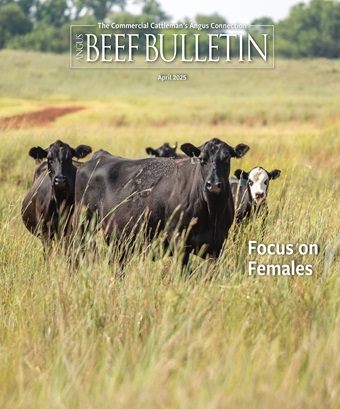Research Roundup
Evaluating heifer development strategies.
March 25, 2025
Development rates
University of Nebraska researchers conducted a three-year study to evaluate rates of gain (Lo or Hi) of heifers during winter development on growth rates, reproduction and economic performance. Heifers were supplemented January-May with dried distillers’ grains to gain at a rate of either 0.75 pounds (lb.) per day or 1.50 lb. per day.

Table 1: Effect of overwintering heifers at differing rates of gain on performance, reproduction and overall growth
The researchers report that Hi-gain heifers were heavier at breeding; however, there was no significant difference in weight at pregnancy diagnosis or precalving (see Table 1), suggesting a compensatory gain. Supplement treatment did not affect attainment of puberty, pregnancy rate or percent calving in the first 21 days of the calving season.
The researchers created a hypothetical enterprise budget to calculate economic returns generated with 100 heifers within each treatment method. There was a difference in net return, with the Lo-gain heifers returning $31.26 more per heifer.
“Results indicate developing heifers to a lower rate of gain may reduce input costs and provide flexibility determining an overwinter supplementation rate and overall rate of gain,” the researchers concluded.
You can read the full report at https://bit.ly/42kFMrJ.
Bunk space
While limit-feeding calves a high-energy diet during the growing period can improve feed efficiency compared to feeding a high-roughage diet ad libitum, providing adequate bunk space is critical. For cattle weighing 397-838 pounds (lb.), the Guide for the Care and Use of Animals in Agricultural Research and Teaching recommends 18-22 inches (in.) of bunk space per head. However, many consulting nutritionists offer recommendations of less.
Kansas State University researchers evaluated the effects of bunk space on the growth and performance of beef heifers limit-fed a high-energy corn and corn coproduct diet in pens containing 18-28 heifers.
For the 56-day study, 332 heifers were randomly assigned to treatments of 6, 10, 14 or 18 in. of bunk space. They were limit-fed a high-energy diet to provide 88 and 59 Mcal of net energy for maintenance (NEm) and growth (NEg), respectively, per 100 lb. of dry matter. They were fed once daily at 2% of body weight.
Pen average body weights did not differ. Bunk space did not affect average daily gain (ADG), dry-matter intake (DMI) or gain-to-feed ratio. There was more variation in the ADG of heifers allotted 14 in. of bunk space than groups allotted 6, 10 or 18 in.
Visit the https://bit.ly/3QmqKdO to read the whole report.

Table 2: Effect of bunk space allotment on growth performance of limit-fed growing heifers*
Topics: Management , Equipment / Facilities , Female Foundations , Nutrition , Reproduction
Publication: Angus Beef Bulletin
Issue: April 2025



